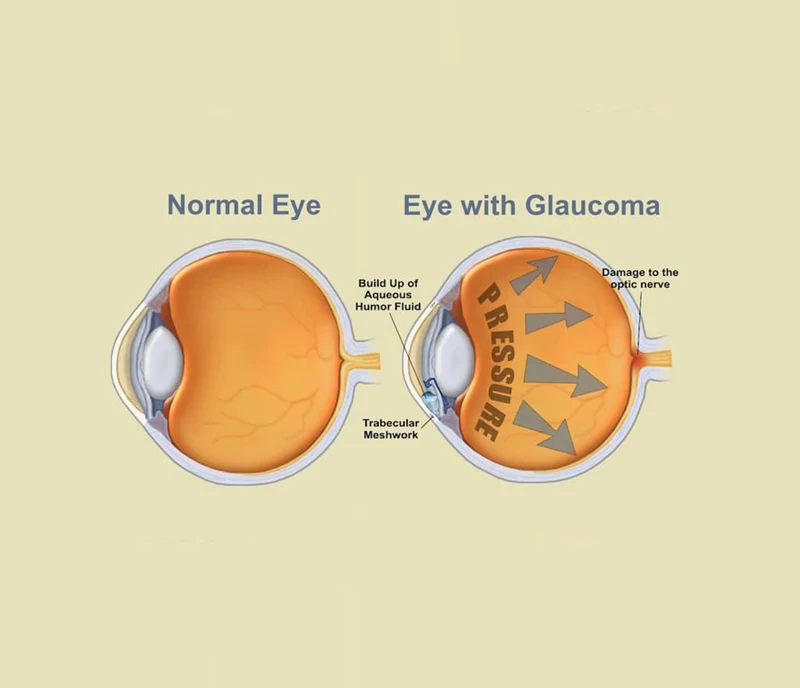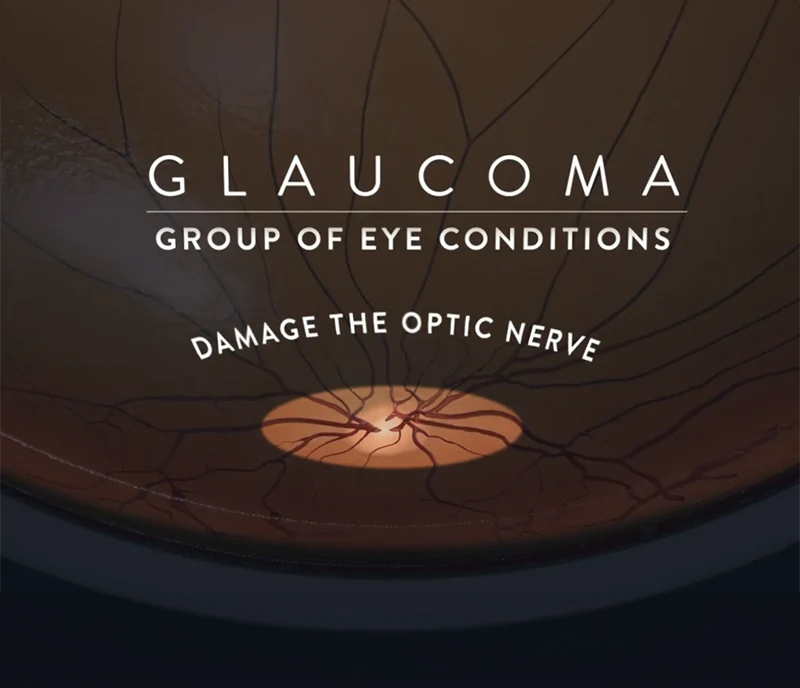
Glaucoma
Glaucoma is the leading cause of
Trusted Source
Current Glaucoma Programs
CDA
Go to Source
blindness
in the United States. According to the American Academy of Ophthalmology (AAO), only half of people with glaucoma are aware they have the
Trusted Source
Half of Those with Glaucoma Don’t Know It; Are You At Risk?
American Academy of Ophthalmology
Go to Source
condition
. At Columbus Ophthalmology Associates, we work with patients from Columbus and Central Ohio to halt the progression of the disease with early detection and personalized treatment plans.
What is Glaucoma?
Glaucoma is a group of eye conditions that damage the optic nerve, often due to increased pressure inside the eye (intraocular pressure). This damage can lead to gradual vision loss and, if left untreated, blindness. Glaucoma typically has no early symptoms, making regular eye exams essential for early detection, especially for individuals over 40 or with a family history of glaucoma. Treatment options can help manage the condition and protect vision.

Be Aware of Glaucoma Symptoms
Learn the risks. Be proactive.
What are the symptoms of glaucoma, and how do they affect you? Read below to learn more.
Types of Glaucoma
Open-Angle Glaucoma Signs and Symptoms
Primary open-angle glaucoma is the most prevalent form of glaucoma and often progresses slowly, remaining unnoticed for years while causing vision damage. Common signs include:
- Absence of early symptoms
- Gradual loss of peripheral vision, typically affecting both eyes
- Tunnel vision in the later stages of the condition
Closed-Angle Glaucoma Signs and Symptoms
Closed-angle glaucoma (also called narrow-angle glaucoma) can be very rapid in onset, and patients generally have symptoms that occur quite suddenly. It is related to the anatomical changes of the eye and can be picked up during a routine eye exam before any damage has occurred.
Simple, outpatient laser treatment is effective in curing this form of the disease. Here are the signs and symptoms:
- Intense eye pain
- Nausea and vomiting, often with the eye pain
- Sudden visual disturbances, especially in low light or at night
- Blurred vision
- Halos appearing around lights
- Eye redness

Prevention, Diagnosis & Treatment
Glaucoma is often called the “sneak thief of sight” because, in many cases, there are no symptoms. Fortunately, glaucoma is highly treatable, especially when caught early. Detecting the condition in its early stages is crucial for preventing significant vision loss or blindness.
An annual eye examination at Columbus Ophthalmology Associates, with the eyes fully dilated, is the best and earliest means of detecting glaucoma.
At Columbus Ophthalmology Associates, glaucoma treatment focuses on reducing intraocular pressure through medications, laser therapies, and surgical options. These approaches improve fluid drainage from the eye, helping to manage the condition and protect vision. In the early stages of glaucoma, lasers or medications are used. If the condition worsens, surgical procedures are performed. Below are the surgical options for both types of glaucoma.
Surgical Treatment for Closed-Angle Glaucoma
Laser Peripheral Iridotomy
The only available laser surgical treatment for closed-angle glaucoma, this procedure uses a very focused beam of light to create a hole on the outer edge of the iris, where fluid is blocked. This opening allows the iris to fall back from the fluid channel, allowing the fluid to flow naturally and decreasing dangerous levels of pressure inside the eye.
Laser Treatment for Open-Angle Glaucoma
Selective Laser Trabeculoplasty (SLT)
Selective Laser Trabeculoplasty (SLT) is a minimally invasive glaucoma surgery that targets the eye’s drainage tissue to enhance fluid outflow and reduce intraocular pressure. After numbing the eye with drops, a laser is applied to the tissue, initiating a biological response that improves fluid drainage and relieves eye pressure. This advanced laser surgery takes only 5-10 minutes and allows most patients to resume normal activities, including driving, immediately afterward. Unlike older treatments, SLT minimizes tissue damage and scarring, making it a safe and repeatable option among modern glaucoma treatment options.
Surgical Treatment for Open-Angle Glaucoma
BAERVELDT™ Glaucoma Implants
The Baerveldt implant is a minimally invasive option for patients whose intraocular pressure (IOP) cannot be controlled by traditional therapies. This implant uses a specialized fenestration system to regulate bleb height and volume, enhancing IOP control through a larger surface area. It provides effective, long-term pressure relief, making it ideal for advanced glaucoma cases where conventional treatments have proven
Trusted Source
The Baerveldt Glaucoma Drainage Device: Efficacy, Safety, and Place in Therapy
Clinical Ophthalmology
Go to Source
inadequate
.
Hydrus® Microstent
This tiny, canal-based microstent is designed for adults with mild to moderate primary open-angle glaucoma and is performed during cataract
Trusted Source
Outcomes of a Microstent Procedure Combined With Cataract Extraction in Mild/Moderate versus Severe Open Angle Glaucoma
Investigative Ophthalmology and Visual Science
Go to Source
surgery
. Made from biocompatible nitinol, the Hydrus® Microstent is inserted during a straightforward procedure to help improve the natural outflow of fluid in the eye. Long-term studies show significant reductions in medication reliance and surgical intervention rates for patients undergoing this surgical treatment, offering both safety and efficacy in managing IOP over time.
Filtering Microsurgery: Trabeculectomy
A standard surgical procedure for open-angle glaucoma involves making a tiny drainage channel in the sclera (the white part of the eye) in a procedure called trabeculectomy. The new drainage channel allows fluid to flow out of the eye and helps lower eye pressure, preventing or reducing damage to the optic nerve.
After eye drops are used to numb the eye, a laser is applied to the drainage tissue, starting a biological change in the tissue that results in better fluid drainage. This procedure takes about 5 -10 minutes, there are no patches required, and there are no restrictions in post-laser activities.
Most patients can drive themselves to the procedure and are able to carry on normal activities immediately afterward. This advanced laser treatment does not have the associated damage to other tissues or adverse scarring effects that the first-generation Argon laser did. For this reason, SLT can be repeated multiple times to relieve eye pressure if necessary.
OMNI® Surgical System
The OMNI® procedure provides a comprehensive approach to glaucoma management by restoring the eye’s natural drainage system. The device accesses and dilates the Schlemm’s canal through micro-incisions, enhancing fluid outflow and potentially reducing the need for glaucoma medications. This minimally invasive procedure can be performed with or without cataract surgery, offering flexibility and effective pressure reduction for patients with open-angle glaucoma.
You can learn about glaucoma by visiting the Glaucoma Research Foundation website.
Ex-Press Shunt
Smaller than a grain of rice, this filtration device relieves high eye pressure in patients with open-angle glaucoma when drops and other surgical treatments have been unsuccessful. Placed between the inner and outer layers of the eye, the Ex-Press Shunt bypasses the eye’s damaged drainage system, allowing excess fluid to drain and reducing eye pressure.

Dr. Derick & Glaucoma
Dr. Robert Derick has been an innovator and leading instigator of several innovative glaucoma procedures. Fellowship-trained at The John Hopkins Wilmer Eye Institute, he was one of the first surgeons in the country and the state of Ohio to perform many of these cutting-edge procedures and continues to be a leader in this field.
A member of the American Glaucoma Society for over two decades and a board member of the Glaucoma Research Foundation, Dr. Derick has performed tens of thousands of glaucoma surgeries during his tenure at COA.
FAQs About Glaucoma Treatment
Can glaucoma be prevented?
Glaucoma cannot be entirely prevented, but early detection and treatment can help slow its progression and preserve vision. Regular eye exams, especially if you are over 40 or have a family history of glaucoma, are key to catching the condition early and managing it effectively.
How do I know which glaucoma treatment is right for me?
The right glaucoma treatment depends on several factors, including the type and severity of the condition and your overall eye health. Your eye doctor will evaluate your specific situation and recommend the most appropriate treatment, which may include medications, laser procedures, or surgery.
What is the success rate of glaucoma treatments?
Glaucoma treatments are generally very effective in reducing intraocular pressure and slowing disease progression. Success rates vary depending on the type of treatment and the individual’s response, but with proper management, many patients can maintain good vision for a long time. Early diagnosis and consistent follow-up care play a vital role in treatment success.
Convenient Locations in and Around Columbus
We Look Forward to Seeing You!

5155 Bradenton Avenue
Dublin OH, 43017

5965 E Broad St #480
Columbus OH, 43213

4176 Kelnor Drive
Grove City OH, 43123
Schedule an Appointment
If you’re experiencing symptoms related to glaucoma or other eye conditions, contact us today to schedule an appointment with one of our expert eye doctors. Our eye surgeons and ophthalmologists provide comprehensive eye care to patients throughout Columbus and Central Ohio, helping you protect your eye health and preserve your vision.
CDA. Current Glaucoma Programs. cdc.gov/vision-health/php/glaucoma-programs/index.html#. Accessed October 7, 2024.
American Academy of Ophthalmology. Half of Those with Glaucoma Don’t Know It; Are You At Risk? https://www.aao.org/newsroom/news-releases/detail/half-of-those-with-glaucoma-don-t-know-it-are-you-. Accessed October 7, 2024.
Clinical Ophthalmoloyg. The Baerveldt Glaucoma Drainage Device: Efficacy, Safety, and Place in Therapy. ncbi.nlm.nih.gov/pmc/articles/PMC7522304/#. Accessed October 7, 2024.
Investigative Ophthalmology and Visual Science. Outcomes of a Microstent Procedure Combined With Cataract Extraction in Mild/Moderate versus Severe Open Angle Glaucoma. https://iovs.arvojournals.org/article.aspx?articleid=2781490. Accessed October 7, 2024.
The doctors at Columbus Ophthalmology Associates have either authored or reviewed the content on this site.


